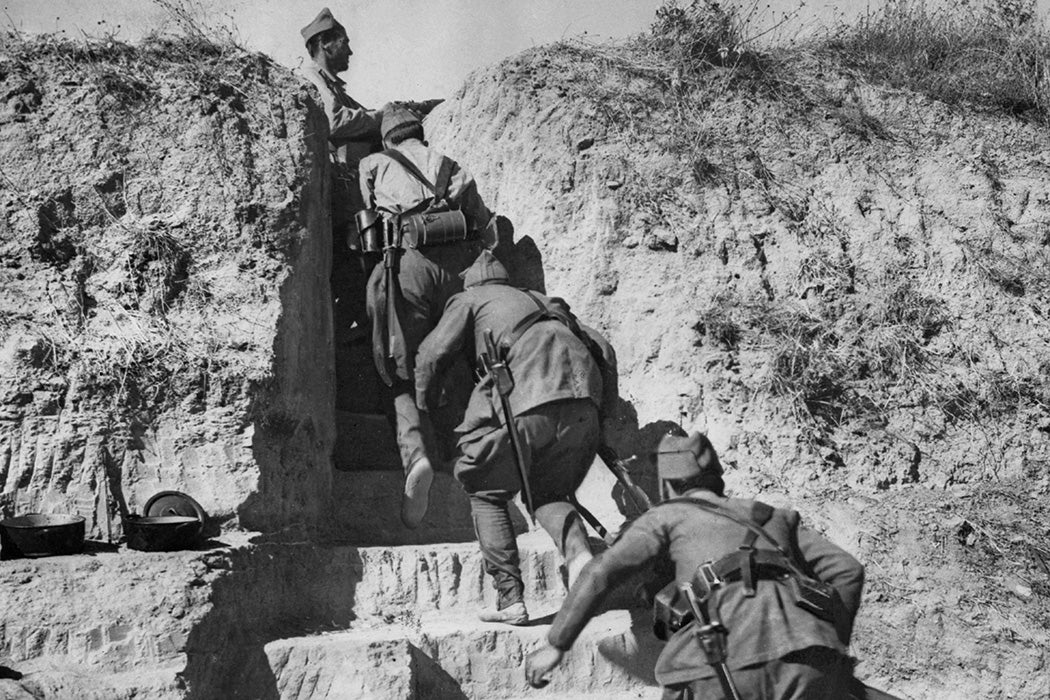The “foreign fighter” who travels abroad to fight in another country’s war isn’t a new figure on the historical stage. Before Afghanistan and Ukraine, there were International Brigades of the Spanish Civil War (1936–1939). These veterans of the losing Republican side were shunned and sometimes even persecuted when they returned to their home countries because of their communist or alleged communist associations. Many certainly were officially unwelcome, but others found a way to continue fighting fascism across Europe during World War II, seeding the resistance to the occupying Nazis. For them, the antifascist struggle lasted from 1936 to 1945.
In the United States, as historian Jorge Marco details, American vets of the Spanish Republic were recruited by the Office of Strategic Services (OSS) to train guerrilla fighters. The vets worked at Area B, the first and ultimately largest WWII American school of guerrilla warfare, located in the mountains north of Washington, DC.
The American military had experience fighting against guerrillas—for instance in the Philippines at the turn of the twentieth century—but little modern tradition of fighting as guerrillas. Guerrilla warfare, also known as unconventional or irregular warfare, is named after the Spanish for “little war.” The term comes from the resistance to Napoleon during the Peninsula War (1807–1814). It’s generally a strategy of smaller, weaker forces against larger, stronger forces. The OSS had to start from scratch and look beyond the American military for teachers of such tactics.
Communists, both Soviet and Chinese, were masters of the form before World War II. Through their service in Spain, the Americans who helped up set up the OSS guerrilla school were Soviet-trained William Aalto, Irving Goff, and Alexandre Künstlich. These three were, Marco notes, the only Americans trained as guerrilla fighters in Spain. Along with other Spanish Civil War vets, they joined the effort to train a transnational cohort of “US, British, Thai, Norwegians, French, Russians, Yugoslavs, Spanish, Italians, Greeks,” and others on how to work behind enemy lines.
Marco notes that the basic texts at Camp B were translations from the Russian editions of the Soviet Russian Guerrilla Manual and Mao Tse-Tung’s On Guerrilla Warfare. The translations were a “curious collaboration” between former Soviet General Alexander Barmine, “who had fled the Soviet Union in 1933,” and Prince Serge Obolensky, a veteran of the anti-Soviet White Army in the Russian Civil War (1917–1923), where the Soviets had honed their guerrilla tactics.
“The OSS was open-minded when it came to recruiting old left-wingers or even communists who could offer significant military experience and knowledge,” writes Marco, “but tended to give them a low profile so as not to arouse suspicion in the War Department, who were not in favor of their recruitment.”
One thing the OSS wasn’t opened-minded about, continues Marco, was sexuality. William Aalto, legendary in Spain for his guerrilla prowess, was expelled from the American guerrilla program because of his homosexuality.
“The homophobia of his comrades and US Army thus prevented the biggest US expert on guerrilla warfare from taking part in any mission with the OSS during the Second World War,” Marco writes.
Weekly Newsletter
Others Spanish Civil War vets did take part in the OSS’s Operational Groups in North Africa and Europe. Noting that the British were much less welcoming to British veterans of the Spanish Civil War, Marco cites OSS founder William Donovan’s “exceptional vision” in fostering the continued transfer of guerrilla skills through transnational soldiers.
Of course, such skills can spread in multiple directions. The OSS’s successor organization, the Central Intelligence Agency (CIA), sponsored guerrilla action against Fidel Castro, who had himself come to power in Cuba in 1959 through guerrilla war. One of Castro’s advisors and mentors in guerrilla combat was Alberto Bayo, who two decades earlier had been a Cuban fighting for Republican Spain.







